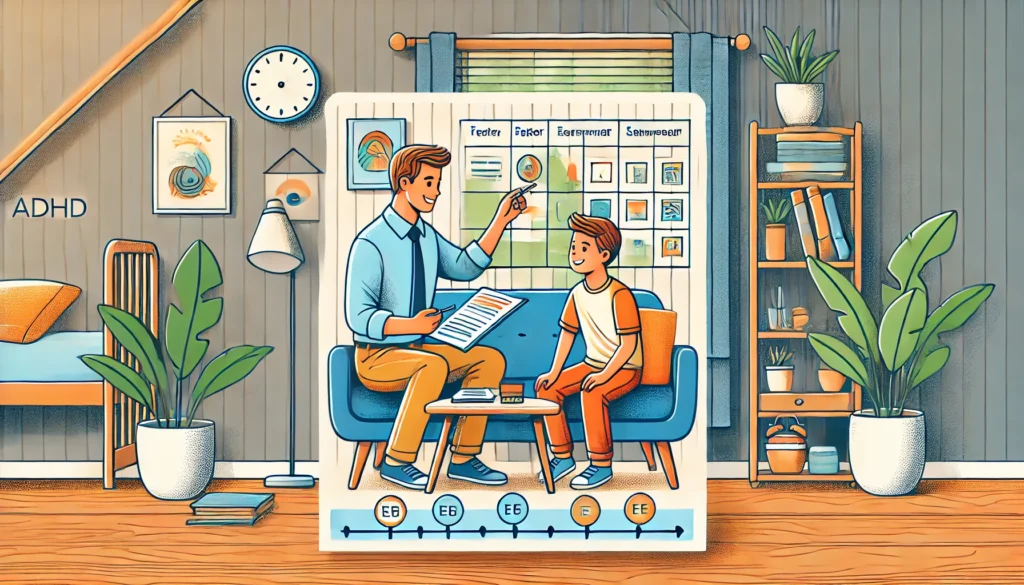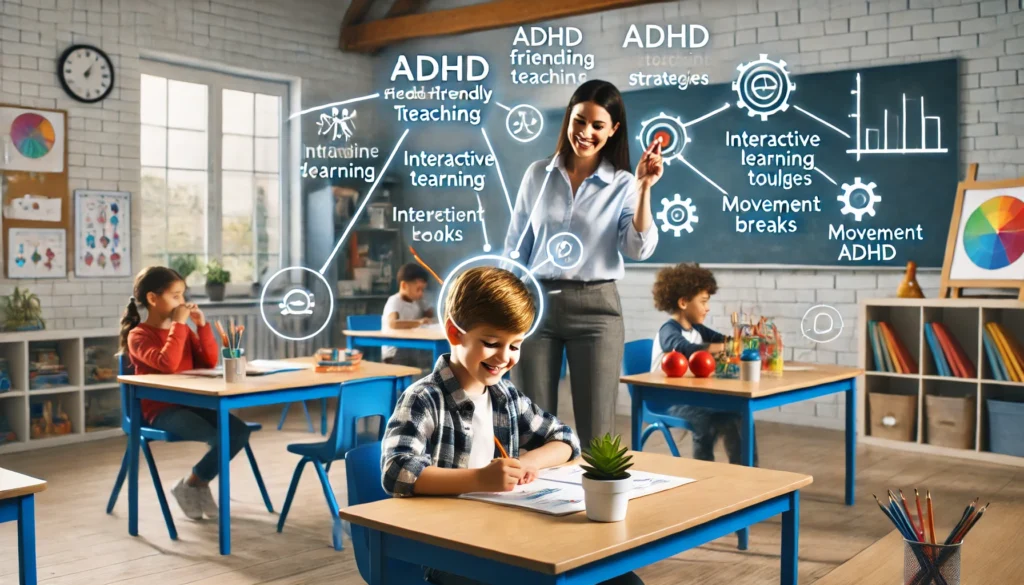Attention-Deficit/Hyperactivity Disorder (ADHD) is a prevalent neurodevelopmental disorder that affects millions of children worldwide. As parents and caregivers seek effective strategies to manage and treat ADHD, the debate between medication and therapy often comes to the forefront. Both approaches have their merits and limitations, and understanding these can help in making informed decisions for childhood ADHD treatment.
You may also like: Enhancing Concentration: Strategies for ADHD
Understanding ADHD in Children
ADHD is characterized by symptoms of inattention, hyperactivity, and impulsivity. These symptoms can significantly impact a child’s academic performance, social interactions, and overall quality of life. The challenge lies in distinguishing ADHD from typical childhood behavior. Diagnosis involves comprehensive evaluations by healthcare professionals, often incorporating input from parents, teachers, and other caregivers.
Symptomatology and Impact
Symptoms of ADHD can vary widely among children, with some exhibiting predominantly inattentive behaviors while others are more hyperactive and impulsive. This variation necessitates a nuanced understanding of how these symptoms impact day-to-day life. Academic challenges often manifest in the form of difficulty following instructions, completing tasks, or maintaining organization. Socially, children may struggle with peer relationships due to impulsive actions or difficulty in understanding social cues.
Diagnostic Process
Accurate diagnosis of ADHD is crucial and involves a multifaceted approach. Healthcare professionals rely on standardized assessment tools alongside subjective reports from individuals who interact with the child regularly. Observations in different settings, such as school and home, provide a comprehensive view of the child’s behavior. It’s essential to differentiate ADHD from other conditions that might mimic its symptoms, such as anxiety or learning disabilities.
Co-existing Conditions
Many children with ADHD also experience co-existing conditions, which can complicate the diagnostic and treatment process. Common comorbidities include learning disabilities, anxiety disorders, and oppositional defiant disorder. Understanding the full spectrum of a child’s challenges allows for a more tailored treatment approach, addressing all aspects of their mental health and developmental needs.
Historical Perspective
Historically, ADHD treatment has evolved alongside our understanding of the disorder. Initially, ADHD was primarily addressed through behavioral interventions. With advancements in pharmacology, medication became a significant treatment modality in the latter half of the 20th century. Today, the debate continues on the optimal approach to treating ADHD in children.
Early Approaches
In the early years, ADHD was often misunderstood and misdiagnosed. Treatment primarily focused on behavioral interventions, with an emphasis on modifying the child’s environment to reduce distractions and reinforce positive behaviors. Educators and parents were encouraged to implement structured routines and consistent discipline strategies to manage symptoms.
Rise of Pharmacological Solutions
The introduction of stimulant medications in the mid-20th century revolutionized ADHD treatment. Drugs like methylphenidate and amphetamine offered a new avenue for symptom management, providing rapid improvements for many children. This shift sparked a surge in research exploring the neurobiological underpinnings of ADHD and the role of medication in addressing these challenges.
Current Debates
Today, the discussion around ADHD treatment is more nuanced, with increasing recognition of the benefits of combining medication with therapy. While medication can address neurochemical imbalances, therapy offers skills and strategies for managing behaviors. The debate now centers around finding the right balance and understanding how to tailor treatments to individual needs effectively.

Medication for ADHD
Types of Medication
The primary medications used to treat ADHD in children are stimulants, such as methylphenidate (Ritalin) and amphetamine (Adderall). These drugs work by increasing levels of certain neurotransmitters in the brain, improving attention and focus. Non-stimulant medications, such as atomoxetine (Strattera), are also available and may be preferred for children who do not respond well to stimulants or experience significant side effects.
Stimulant Medications
Stimulants are often the first line of treatment for ADHD due to their effectiveness in enhancing concentration and reducing hyperactive behaviors. They work by boosting dopamine and norepinephrine levels, neurotransmitters linked to attention and self-control. Despite their efficacy, stimulants require careful monitoring to manage potential side effects and ensure appropriate dosing.
Non-stimulant Alternatives
For children who cannot tolerate stimulants, non-stimulant medications offer an alternative. Atomoxetine works differently by selectively inhibiting norepinephrine reuptake, leading to improved attention and decreased impulsivity. These medications may take longer to show effects but are valuable for children with specific sensitivities or co-existing conditions that contraindicate stimulant use.
Emerging Pharmacological Options
Recent advancements have introduced new medications and formulations designed to offer more flexibility in managing ADHD symptoms. Extended-release versions aim to provide longer-lasting effects with fewer doses, improving adherence and minimizing rebound symptoms. Research into novel compounds continues, with the goal of expanding the therapeutic toolkit for ADHD.
Benefits and Risks
Medication can be highly effective in managing ADHD symptoms, often leading to rapid improvements in behavior and concentration. However, these benefits must be weighed against potential side effects, which can include sleep disturbances, decreased appetite, and mood swings. Long-term use and dependence are also concerns that parents and caregivers must consider.
Short-term Efficacy
The immediate benefits of ADHD medications are often evident, with many children experiencing significant reductions in symptoms within days. This rapid response can enhance academic performance and social interactions, providing relief for both the child and their family. Regular follow-up with healthcare providers ensures that the treatment remains effective and side effects are managed.
Side Effects and Management
Common side effects of ADHD medication include insomnia, appetite suppression, and potential mood changes. Parents and caregivers need to be vigilant in observing these effects and communicating with healthcare providers to adjust doses or explore alternative options. Strategies such as adjusting medication timing or incorporating dietary changes can help mitigate some adverse effects.
Long-term Considerations
The long-term use of ADHD medications raises questions about dependency and potential impacts on development. While research indicates that these medications are generally safe for extended use, ongoing monitoring is essential. Regular evaluations allow for adjustments in treatment as the child grows, ensuring that the benefits continue to outweigh the risks.
Current Trends
Recent trends in ADHD medication highlight the importance of personalized treatment plans. Advances in genetic testing and pharmacogenomics offer the promise of tailoring medication choices to individual genetic profiles, potentially minimizing side effects and maximizing efficacy.
Pharmacogenomics in ADHD
Pharmacogenomics explores how genetic differences affect individual responses to medications. In ADHD treatment, this field holds the potential to revolutionize prescribing practices by identifying which medications are likely to be most effective for a given child. This approach aims to reduce the trial-and-error process currently associated with finding the right medication.
Personalized Treatment Plans
The move towards personalized medicine in ADHD treatment reflects a broader trend in healthcare. By considering genetic, environmental, and lifestyle factors, healthcare providers can develop more targeted treatment strategies. This individualized approach seeks to optimize outcomes and enhance the quality of life for children with ADHD.
Future Directions
As research into ADHD and pharmacogenomics progresses, new insights are likely to emerge, shaping future treatment paradigms. Continued investment in understanding the genetic basis of ADHD will pave the way for more precise interventions, minimizing side effects and improving overall effectiveness.
Therapy for ADHD
Behavioral Therapy
Behavioral therapy is a cornerstone of non-pharmacological ADHD treatment. It involves strategies to reinforce desirable behaviors and reduce unwanted ones. Techniques such as positive reinforcement, time-outs, and structured routines are commonly employed. Behavioral therapy is often most effective when it involves parents, teachers, and the child collaboratively.
Techniques and Strategies
Behavioral therapy employs a range of techniques to modify a child’s behavior. Positive reinforcement encourages desirable behaviors by offering rewards, while time-outs and consequences help manage impulsivity and aggression. Structured routines provide predictability and help children develop a sense of security and control over their environment.
Role of Parents and Educators
The involvement of parents and educators is crucial in the success of behavioral therapy. Training and support enable them to implement strategies consistently across different settings. Collaboration between parents, teachers, and therapists ensures that the child receives consistent feedback and reinforcement, enhancing the effectiveness of the therapy.
Adapting to Individual Needs
Behavioral therapy is not a one-size-fits-all solution and must be tailored to each child’s unique needs. Therapists work closely with families to identify specific goals and challenges, adapting techniques to suit the child’s developmental level and personality. This personalized approach maximizes the therapy’s impact and fosters long-term improvements.
Cognitive Behavioral Therapy (CBT)
Cognitive Behavioral Therapy (CBT) is another therapeutic approach that can benefit children with ADHD. CBT focuses on identifying and altering negative thought patterns and behaviors. Although traditionally used for older children and adults, adaptations of CBT for younger children are emerging, showing promise in improving self-regulation and executive functioning.
Principles of CBT
CBT is grounded in the idea that thoughts, feelings, and behaviors are interconnected. By helping children recognize and change negative thought patterns, CBT aims to influence behavior positively. Techniques such as cognitive restructuring and problem-solving skills are employed to enhance self-awareness and self-control.
Adapting CBT for Children
Adapting CBT for younger children involves using age-appropriate language and activities to engage them in the therapeutic process. Interactive techniques such as role-playing and storytelling can help children grasp complex concepts and apply them to real-life situations. These adaptations ensure that CBT is accessible and effective for children with ADHD.
Benefits for ADHD
CBT offers several benefits for children with ADHD, including improved self-regulation, enhanced problem-solving skills, and reduced emotional reactivity. By focusing on the cognitive aspects of ADHD, CBT complements behavioral interventions and can lead to lasting changes in how children perceive and respond to challenges.
Benefits and Limitations
Therapy provides children with ADHD the tools to manage their symptoms and develop coping strategies. It can lead to lasting improvements and has no pharmacological side effects. However, therapy requires time, consistency, and often the active involvement of family members, which can be challenging for some families.
Long-term Benefits
The skills and strategies learned in therapy can have lasting impacts, equipping children with the tools they need to manage their symptoms throughout their lives. By fostering self-awareness and self-regulation, therapy promotes resilience and independence, enabling children to navigate challenges more effectively.
Absence of Side Effects
One of the significant advantages of therapy over medication is the absence of pharmacological side effects. Therapy provides a safe and holistic approach to managing ADHD, focusing on empowering children rather than relying solely on medication. This aspect makes therapy an attractive option for families concerned about the long-term use of medication.
Challenges and Barriers
Despite its benefits, therapy presents challenges, including the time commitment required for regular sessions and the need for active family involvement. Access to qualified therapists and financial constraints can also pose barriers for some families. Addressing these challenges is essential to ensure that all children with ADHD can benefit from therapeutic interventions.

The Combined Approach
Evidence-Based Practices
Research increasingly supports a combined approach, integrating both medication and therapy, as the most effective treatment for many children with ADHD. This multimodal treatment addresses both the neurobiological and behavioral aspects of the disorder, offering a comprehensive strategy to manage symptoms.
Integrating Medication and Therapy
Combining medication and therapy leverages the strengths of both approaches, providing a balanced treatment plan. While medication addresses the neurochemical imbalances associated with ADHD, therapy offers skills and strategies to manage behaviors. This integration enhances overall treatment efficacy and supports holistic development.
Supporting Evidence
A growing body of evidence highlights the benefits of a combined approach, with studies showing improved outcomes in academic performance, social interactions, and overall functioning. Children receiving both medication and therapy often experience faster and more sustained improvements than those on either treatment alone.
Holistic Treatment Goals
The goal of a combined approach is to address the full spectrum of ADHD symptoms, considering both the child’s biological needs and behavioral challenges. This comprehensive strategy promotes long-term success by equipping children with the tools to manage their symptoms across different contexts and life stages.
Practical Considerations
Implementing a combined approach necessitates coordination between healthcare providers, therapists, and families. It requires ongoing assessment and adjustment of treatment plans to meet the changing needs of the child. The goal is to strike a balance that maximizes benefits while minimizing risks and side effects.
Coordination and Communication
Effective implementation of a combined approach relies on seamless coordination and communication among all parties involved. Regular meetings and updates ensure that everyone is aligned in their efforts to support the child. This collaborative approach fosters consistency and reinforces the child’s progress across different settings.
Adapting to Change
Children’s needs and circumstances evolve over time, necessitating flexibility in treatment plans. Ongoing assessments and adjustments are critical to maintaining treatment efficacy and addressing emerging challenges. By remaining adaptable, healthcare providers can ensure that treatment continues to meet the child’s evolving needs.
Balancing Benefits and Risks
A combined approach aims to balance the immediate benefits of medication with the long-term gains of therapy. Careful monitoring of side effects and regular evaluation of progress help maintain this balance, ensuring that the child receives optimal support while minimizing potential risks.
Future Implications
As our understanding of ADHD continues to evolve, so too do the treatment options. Future implications include advancements in neuroimaging and biomarker research, which may provide deeper insights into the underlying mechanisms of ADHD, paving the way for more targeted and effective treatments.
Neuroimaging and Biomarkers
Advancements in neuroimaging technologies offer promising avenues for understanding the brain structures and functions associated with ADHD. By identifying specific biomarkers, researchers can gain insights into the neurobiological basis of ADHD, potentially leading to more accurate diagnoses and targeted interventions.
Role of Biomarker Research
Biomarker research in ADHD aims to identify biological indicators that can aid in diagnosis and treatment. By understanding the genetic and neurochemical profiles associated with ADHD, clinicians can develop more precise treatment strategies. This research holds the potential to transform the way ADHD is diagnosed and managed.
Implications for Treatment
The insights gained from neuroimaging and biomarker research could lead to the development of novel treatments tailored to individual neurobiological profiles. This precision medicine approach seeks to enhance treatment efficacy and minimize side effects, offering new hope for children with ADHD and their families.
Personalized Medicine
The future of ADHD treatment lies in personalized medicine. By leveraging genetic information and understanding individual differences in ADHD presentation, healthcare providers can offer more tailored treatment plans. This approach holds the potential to improve outcomes and reduce the trial-and-error nature of current treatment strategies.
Genetic Insights and Treatment
Genetic research continues to uncover the complex interplay of genes involved in ADHD, paving the way for more personalized treatment approaches. Understanding these genetic factors allows for more informed decisions regarding medication choices and therapeutic interventions, optimizing outcomes for each child.
Reducing Trial-and-Error
Personalized medicine aims to reduce the trial-and-error approach currently prevalent in ADHD treatment. By tailoring interventions to individual genetic and neurobiological profiles, clinicians can increase treatment efficacy and reduce the time spent finding the right combination of medication and therapy.
Enhancing Treatment Outcomes
The ultimate goal of personalized medicine in ADHD is to enhance treatment outcomes by providing tailored interventions that address each child’s unique needs. This approach seeks to empower children with ADHD to reach their full potential, improving their quality of life and enabling them to thrive in various aspects of life.

Conclusion
Deciding between medication and therapy for treating childhood ADHD is not a one-size-fits-all proposition. Each child is unique, and treatment plans should reflect individual needs, preferences, and circumstances. By considering both historical context and current trends, parents and caregivers can make informed decisions about how to best support their child’s health and well-being.
Ultimately, the goal is to empower children with ADHD to thrive academically, socially, and emotionally, equipping them with the tools they need to navigate life’s challenges successfully.
Further Reading:
Attention-Deficit/Hyperactivity Disorder (ADHD)
Behavioral Treatments for Kids With ADHD
Important Note: The information contained in this article is for general informational purposes only, and should not be construed as health or medical advice, nor is it intended to diagnose, prevent, treat, or cure any disease or health condition. Before embarking on any diet, fitness regimen, or program of nutritional supplementation, it is advisable to consult your healthcare professional in order to determine its safety and probable efficacy in terms of your individual state of health.
Regarding Nutritional Supplements Or Other Non-Prescription Health Products: If any nutritional supplements or other non-prescription health products are mentioned in the foregoing article, any claims or statements made about them have not been evaluated by the U.S. Food and Drug Administration, and such nutritional supplements or other health products are not intended to diagnose, treat, cure, or prevent any disease.


